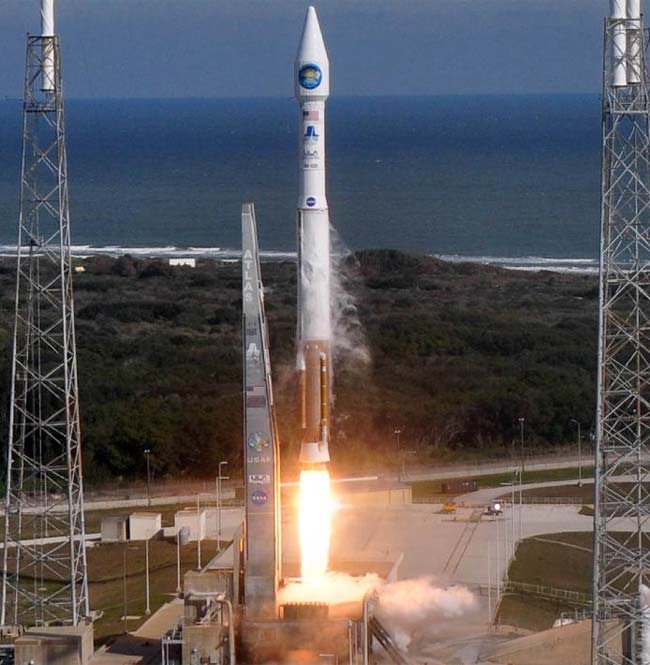NASA Launches New Spacecraft to Study the Sun

A new NASA spacecraft aimed at studying the inner workingsof our sun blasted off Thursday to begin a five-year mission to betterunderstand the mysteries of Earth?s star.
The Solar Dynamics Observatory (SDO) lifted off atop anAtlas 5 rocket at 10:23 a.m. EST (1523 GMT) from Launch Complex 41 at CapeCanaveral Air Force Station in Florida.? A first launch attempt on Wednesdaywas stymied by strong winds.
The $850 million mission will take the most detailed, comprehensivemeasurements yet of our closest star ? with 10 times better resolution than HDtelevision ? using three state-of-the-art instruments onboard.
"To the naked eye, the sun appears as a constant paleyellow ball," said SDO project scientist Madhulika Guhathakurta ofNASA Headquarters in Washington, D.C., during a Tuesday briefing. But actuallythe sun is a volatile and unpredictable body, full of turmoil that scientistsstill don't understand, she said.
"SDO is designed to probe solar variability,"Guhathakurta said. "It will revolutionize our view of the sun."
The discoveries made by the probe will help develop betterways of forecasting solar weather, inlcuding the violent flares ofcharged particles that sometimes erupt from the sun and can disrupt satellitesand power grids on Earth.
"Our sun affects our lives more and more as we dependmore and more on technology," said SDO project scientist Dean Pesnell atNASA?s Goddard Space Flight Center in Greenbelt, Md. "We would like topredict this magnetic field, to predict what's going to happen in solaractivity and to say a solar flare is coming."
Get the Space.com Newsletter
Breaking space news, the latest updates on rocket launches, skywatching events and more!
One such flare, a March 1989 solar storm, knocked out thepower supply in Quebec and disrupted power and communications across NorthAmerica.
"The goal of an experiment like [this] is not just totake the data but to develop a real physical understanding of what goes on sowe can make more sophisticated predictions," said Alan Title of theLockheed Martin Solar and Astrophysics Laboratory, principal investigator ofSDO's Atmospheric Imaging Assembly instrument.
The scientists are also intent on sharing SDO's wealth ofdata beyond the scientific world. They will pipe their data to a freedownloadable iPhone application ? 3D sun ? that displays a constant stream ofupdated 3D views of the sun from SDO and other solar probes.
"This is way cool," Guhathakurta said,demonstrating the app.
The spacecraft will undergo about two months of calibrationand testing before it begins taking real science observations.
"We can't wait to get this data started," said SDOproject manager Elizabeth Citrin, also at NASA's Goddard Space Flight Center.
The liftoff was the second this week for NASA, whichlaunched the space shuttle Endeavour on a 13-day trip to the InternationalSpace Station Monday.
Click here for more info on the iPhone app:http://itunes.apple.com/ca/app/3d-sun/id347089078?mt=8
- Video ? NASA's New Solar Observatory
- Images: Hyperactive Sun
- Video Show: Attack of the Sun
Join our Space Forums to keep talking space on the latest missions, night sky and more! And if you have a news tip, correction or comment, let us know at: community@space.com.

Clara Moskowitz is a science and space writer who joined the Space.com team in 2008 and served as Assistant Managing Editor from 2011 to 2013. Clara has a bachelor's degree in astronomy and physics from Wesleyan University, and a graduate certificate in science writing from the University of California, Santa Cruz. She covers everything from astronomy to human spaceflight and once aced a NASTAR suborbital spaceflight training program for space missions. Clara is currently Associate Editor of Scientific American. To see her latest project is, follow Clara on Twitter.










